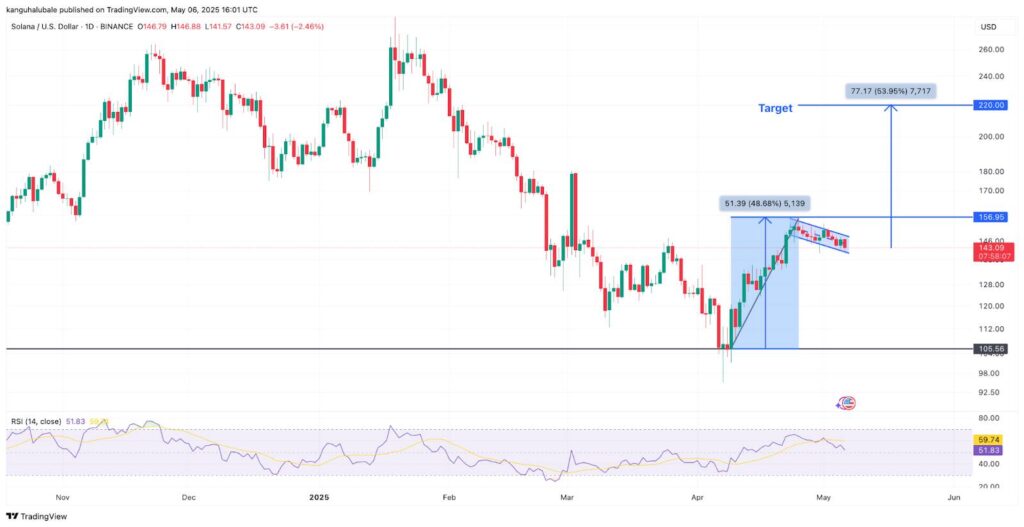In an impressive surge, Solana’s stablecoin supply skyrocketed by a remarkable 156% in 2025, hitting a new record of over $13 billion. This milestone reinforces Solana’s position within the decentralized finance (DeFi) ecosystem, where stablecoins play a crucial role in driving liquidity and elevating demand for its native token, SOL. According to recent data, Circle’s USDC has emerged as the preferred stablecoin for Solana users, accounting for a significant 77% of the market share.
Solana is not just making waves in the stablecoin arena; its total value locked (TVL) has also grown impressively, reaching approximately $7.65 billion—an increase of 25% in less than a month. This places Solana as a strong competitor, leading in decentralized exchange (DEX) volumes with a commanding share of 27.7%, surpassing Ethereum and BNB Chain.
“Increased stablecoin inflows have historically coincided with SOL price rallies. Notably, a substantial rise in stablecoin activity has often foreshadowed significant price movements.”
The SOL token recently established a bull flag pattern, hinting at potential upward movement. With analysts suggesting a target price of $220, this chart pattern is garnering attention. Although SOL faced some turbulence after hitting $156 in late April, it remains poised for further advancement, especially if it can maintain support within the $120 to $130 range.
The positivity surrounding Solana is further evidenced by a 44% increase in deposits on its liquid staking application, Sanctum, as well as substantial growth on other platforms like Jito and Kamino. Additionally, Solana’s daily transaction count surged by 25% recently, reflecting the network’s growing activity and user engagement.
As Solana continues to carve out its niche in the ever-evolving cryptocurrency landscape, its combination of robust stablecoin performance, increasing TVL, and significant transaction activity presents a compelling narrative worth watching.
Key Takeaways from Solana’s Recent Performance
The recent developments in Solana’s ecosystem may significantly impact its users and investors. Here are the key points to consider:
- Stablecoin Supply Surge:
- Solana’s stablecoin supply rose by 156% in 2025, reaching a new record of $12 billion.
- Stablecoins on Solana recently surpassed $13 billion in issuance.
- Circle’s USDC remains the top choice among Solana users, holding a 77% market share.
- Total Value Locked (TVL) Growth:
- Solana’s TVL increased by 25% to $7.65 billion.
- It ranks as the second-largest blockchain by TVL and leads in decentralized exchange (DEX) volume.
- Daily transaction counts on Solana have risen by 25% to 57.77 million
- SOL Price Analysis:
- SOL price has formed a bull flag pattern, indicating potential upward movement.
- The price target for SOL could reach $220, indicating a possible rise of 53%.
- Maintaining support between $120 – $130 is critical for future price increases.
- Market Impact:
- Stablecoins play a vital role in driving liquidity within Solana’s DeFi ecosystem.
- Increased stablecoin inflows are historically linked to price rallies, which can influence investor behavior.
- With its growing transaction volume and DEX leadership, Solana is positioned to attract more users and investors.
“Every investment and trading move involves risk, and readers should conduct their own research when making a decision.”
Solana’s Notable Growth: A Comparative Look at the DeFi Landscape
Solana’s impressive metrics highlight its growing significance in the decentralized finance (DeFi) ecosystem, evidenced by its stablecoin supply surging by 156% to reach over $13 billion in 2025. This growth positions Solana uniquely in comparison to its primary competitors, Ethereum and BNB Chain, particularly in terms of total value locked (TVL) and decentralized exchange (DEX) volumes. The recent rise of Solana’s TVL to $7.65 billion, coupled with its commanding 27.7% share of DEX volume, illustrates its effective strategy to gain traction in the DeFi space.
While Solana boasts an expansive integration of stablecoins driving liquidity within its ecosystem, it’s crucial to consider the competitive landscape. Circle’s USDC dominates with a considerable 77% market share among Solana’s stablecoins. This predominance not only showcases Solana’s partnership strengths but raises questions about dependency on a single issuer, presenting potential vulnerabilities if USDC faces regulatory or liquidity challenges. In contrast, Ethereum continues to enjoy broader recognition and a larger user base; however, with higher transaction fees and slower throughput compared to Solana, users may find themselves drawn to Solana’s faster, cost-effective transactions.
Furthermore, while Solana’s recent price movements suggest a bullish outlook with targets around $220, the volatility that accompanies altcoins can pose risks for investors. In contrast, established cryptocurrencies like Bitcoin and Ethereum tend to offer a more stable investment environment. Solana’s volatile nature, particularly with SOL prices fluctuating after reaching $156, can create uncertainty that might deter risk-averse investors.
This robust surge in Solana’s metrics is likely to benefit early adopters, traders looking for high-risk, high-reward opportunities, and developers building within the DeFi ecosystem. However, for traditional investors and larger institutional players, the susceptibility to abrupt price changes and reliance on a dominant stablecoin could lead to hesitance in fully embracing Solana’s offerings. As Solana continues to carve out its niche, it must navigate these competitive waters thoughtfully to sustain its momentum and mitigate risks inherent in the fast-evolving world of cryptocurrency.

















